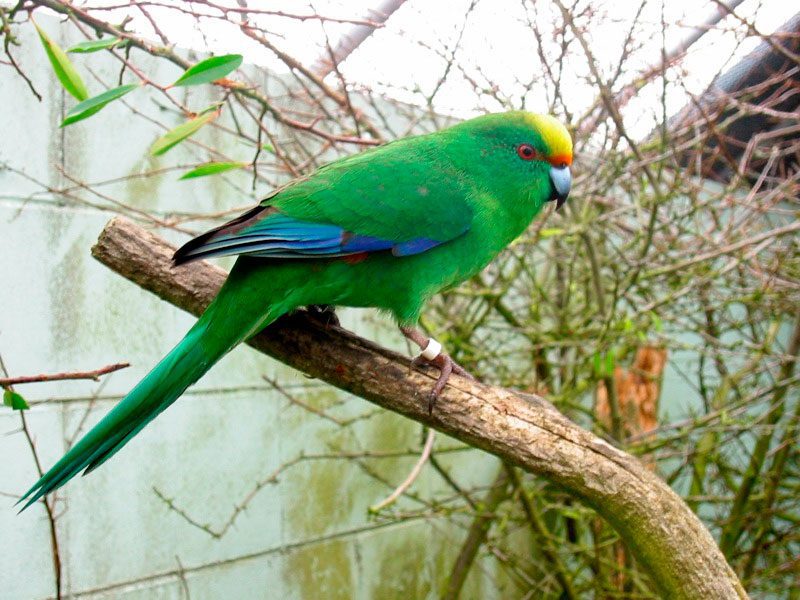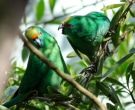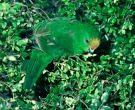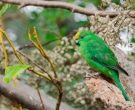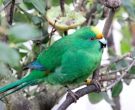Content
|
|---|
Description
19 to 22 cm. length and a weight between 40 and 52 grams for males and between 30 and 41 grams for females.
The Malherbe's parakeet (Cyanoramphus malherbi) they are small bright green parakeets, equipped with a long tail and with a bluish green colour wash in belly and chest.
The wings they have the primary coverts and the edges to the primary external of azure-blue. The crown is lemon-yellow colour and the front band, it reaches the eyes, is orange, as well as two patches on each side of the rump.
The bill is bluish grey, with the tip of black. The eyes are red and the legs are brown.
The colors tend to have a brighter tone in the males.
The youth they are more opaque, especially the patch of front band and the crown, which may be absent. The tail It is short for several weeks after feather. The bill is a pale pink color that darkens gradually when the young bird matures. They have darker the eyes, a reddish brown tone.
- Sound of the Malherbe's parakeet.
Habitat:
The Malherbe's parakeet tends to be quiet and hard to see. A brief and loud chatter or a quieter soft contact call can denote its presence, but locating the bird can be extremely difficult. The Malherbe's parakeet often confused with the Yellow-crowned parakeet.
Even though have been recorded in subalpine bushes and thickets of Matagouri open zones (Discaria toumatou), the Malherbe's parakeet they are predominantly in the forest.
They usually feed in the canopy, but also under frequent places with low vegetation and soil.
Reproduction:
The Malherbe's parakeet can reproduce in every month, with a main breeding period between December and April; incubation peak is in January.
Clutch size media is of approximately 7 eggs, but register a wide range (range of 1 to 10). Egg laying is asynchronous with an interval between eggs of 2 days. The incubation lasts from 21 to 26 days, and the period of breeding ranges between 35 and 45 days.
The females They seem to choose the nesting sites, as well as carry out all the preparation, incubation and breeding, the male provides most of the food during incubation.
It is suspected that the female only feeds the chicks during the first 10-14 days, just as they do other species Cyanoramphus. Once past this period, both sexes take care, equally, feeding the pigeons.
There may be second clutches If there is enough food available, for example, during the sowing of beech, or if the first attempt failed. The female may lay a second clutch when first chicks have, approximately, 2 weeks of age. This leaves the male as the sole provider for both the chicks and the incubating female..
Second clutches are not uncommon; When is food plentiful, some couples can reproduce 3 or 4 times on.
The nests are accessed normally through holes in knots of branches and the main trunk of a tree.
They use all species of you have to build the nest, predominantly the Red beech (69% nests monitored in the continent, n = 138) and dead trees (20%).
Nests may have more than one meter of depth. Records placed nests in heights that range between 2,5 and 26 m.
Food:
The Malherbe's parakeet consume seeds, flowers, buds and small invertebrates (mealybugs and caterpillars). In a year of abundance of fruits, the seeds become the dominant element of their diet, and they seem to be the main food for young people.
Invertebrates seem to play an important role in the diet of this species of parakeet which for the Yellow-crowned parakeet.
Distribution:
Size of the area of distribution (reproduction / resident) 360 km2
To the Malherbe's parakeet les is in areas where the South beeches (Nothofagaceae), in forest valleys in the South Island, the valleys Hawdon and Poulter in the Arthur Pass National Park and the South Branch of the Hurunui Valley in Lake Sumner Forest Park. Are unevenly distributed within these valleys; absent in many parts, but in some other places can be quite common.
They have been transferred to four islands: Maud and Blumine in Marlborough Sounds, Chalky Island in Fiordland, and Largest Island / Tuhua on bay of plenty.
Conservation:
• Current Red List of UICN: critically endangered
• Population trend: Decreasing
This species is the smallest of the class Cyanoramphus along with the Yellow-crowned parakeet.
The Malherbe's parakeet It is the kind of rare parrots of New Zealand. The population was wiped out by rats and stoats introduced by men.
Also the changes in the habitat due to the ungulates and opossums they have affected the species.
Some diseases have been discovered in two of the areas in which live.
It is in progress conservation actions such as the predator control in the three valleys of the continent and the protection of the trees hosting the nests.
The captive breeding programs they have helped to release the birds in 4 Islands cleared of predators. This work is still in progress.
On the Mainland, all populations are monitored closely by the Department of conservation.
The total population It was estimated in 290/690 individuals at the beginning of 2013.
The continent has between 130 and 270 specimens and Islands surrounding between 160 and 420.
"Malherbe's parakeet" in captivity:
Usually they are not in captivity.
A small captive breeding program was established in 2003.
Alternative names:
– Malherbe’s Parakeet, Alpine Parakeet, Malherbe’s Parrot, Orange-fronted Parakeet (English).
– Perruche de Malherbe, Kakariki de Malherbe (French).
– Malherbesittich (German).
– Kakariki-fronte-laranja (Portuguese).
– Perico Maorí Montañés, Perico Maorí Montano (español).
scientific classification:
– Order: Psittaciformes
– Family: Psittaculidae
– Genus: Cyanoramphus
– Scientific name: Cyanoramphus malherbi
– Citation: Souancé, 1857
– Protonimo: Malherbe's Parakeet
Images “Malherbe's parakeet”:
Videos "Malherbe's parakeet"
“Malherbe's parakeet” (Cyanoramphus malherbi)
Sources:
- Avibase
- Parrots of the World – Forshaw Joseph M
- Parrots A Guide to the Parrots of the World – Tony Juniper & Mike Parr
- Birdlife
-
Photos Perico Maori Montano:
(1) – This is one of several birds being bred in captivity at Isaac Peacock Springs wildlife refuge.
Christchurch, New Zealand By Jon Sullivan from Christchurch, New Zealand [CC BY 2.0], via Wikimedia Commons
(2) – Orange-fronted parakeet. Adult male in captivity. Isaacs Wildlife Trust, Christchurch. Image © John Kearvell by John Kearvell – nzbirdsonline
(3) – Orange-fronted parakeet. Captive adult female. Isaacs Wildlife Trust, February 2012. Image © Sabine Bernert by Sabine Bernert www.sabinebernert.fr – nzbirdsonline
(4) – Orange-fronted parakeet. Juvenile feeding. Nelson, January 1983. Image © Department of Conservation (image ref: 10028825) by Dave Crouchley, Department of Conservation Courtesy of Department of Conservation – nzbirdsonline
(5) – Orange-fronted parakeet. Adult male (left) and female in captivity. Isaacs Wildlife Trust, Christchurch. Image © John Kearvell by John Kearvell – nzbirdsonline
- Maori Montane Parakeet Sounds: Johannes Fischer (Xeno-canto)
